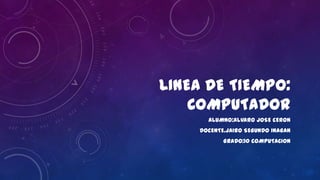
Linea de tiempo
- 1. LINEA DE TIEMPO: COMPUTADOR ALUMNO:ALVARO JOSE CERON DOCENTE.JAIRO SEGUNDO INAGAN GRADO:10 COMPUTACION
- 2. PRIMERA GENERACION LA PRIMERA GENERACION DE COMPUTADORAS ABARCA DESDE EL AO 1938 HASTA EL AÑO 1958, ÉPOCA EN QUE LA TECNOLOGIA ELECTRONICA ERA A BASE DE BULBOS O TUBOS DE VACÍO, Y LA COMUNICACION ERA EN TERMINOS DE NIVEL MAS BAJO QUE PUEDE EXISTIR, QUE SE CONOCE COMO LENGUAJE DE MAQUINA.
- 3. SEGUNDA GENERACION EL INVENTO DEL TRANSISTOR HIZO POSIBLE UNA NUEVA GENERACIÓN DE COMPUTADORAS, MÁS RÁPIDAS, MÁS PEQUEÑAS, Y CON MENORES NECESIDADES DE VENTILACIÓN. SIN EMBARGO, EL COSTO SEGUÍA SIENDO UNA PORCIÓN SIGNIFICATIVA DEL PRESUPUESTO DE UNA COMPAÑÍA. LAS COMPUTADORAS DE LA SEGUNDA GENERACIÓN TAMBIÉN UTILIZABAN REDES DE NÚCLEOS MAGNÉTICOS EN LUGAR DE TAMBORES GIRATORIOS PARA EL ALMACENAMIENTO PRIMARIO. ESTOS NÚCLEOS CONTENÍAN PEQUEÑOS ANILLOS DE MATERIAL MAGNÉTICO, ENLAZADOS ENTRE SÍ, EN LOS CUALES PODÍAN ALMACENARSE DATOS E INSTRUCCIONES. LAS COMPUTADORAS DE LA SEGUNDA GENERACIÓN ERAN SUSTANCIALMENTE MÁS PEQUEÑAS Y RÁPIDAS QUE LAS DE BULBOS, Y SE USABAN PARA NUEVAS APLICACIONES, COMO EN LOS SISTEMAS PARA RESERVACIÓN EN LÍNEAS AÉREAS, CONTROL DE TRÁFICO AÉREO Y SIMULACIONES DE USO GENERAL. LAS EMPRESAS COMENZARON A APLICAR LAS COMPUTADORAS EN LAS TAREAS DE ALMACENAMIENTO DE REGISTROS, COMO MANEJO DE INVENTARIOS, NÓMINA Y CONTABILIDAD.
- 4. TERCERA GENERACION A MEDIADOS DE LOS AÑOS 60 SE PRODUJO LA INVENCIÓN DEL CIRCUITO INTEGRADO O MICROCHIP, POR PARTE DE JACK ST. CLAIRE KILBY Y ROBERT NOYCE. DESPUÉS LLEVÓ A TED HOFF A LA INVENCIÓN DEL MICROPROCESADOR, EN INTEL. A FINALES DE 1960, INVESTIGADORES COMO GEORGE GAMOW NOTÓ QUE LAS SECUENCIAS DE NUCLEÓTIDOS EN EL ADN FORMABAN UN CÓDIGO, OTRA FORMA DE CODIFICAR O PROGRAMAR. A PARTIR DE ESTA FECHA, EMPEZARON A EMPAQUETARSE VARIOS TRANSISTORES DIMINUTOS Y OTROS COMPONENTES ELECTRÓNICOS EN UN SOLO CHIP O ENCAPSULADO, QUE CONTENÍA EN SU INTERIOR UN CIRCUITO COMPLETO: UN AMPLIFICADOR, UN OSCILADOR, O UNA PUERTA LÓGICA. NATURALMENTE, CON ESTOS CHIPS (CIRCUITOS INTEGRADOS) ERA MUCHO MÁS FÁCIL MONTAR APARATOS COMPLICADOS: RECEPTORES DE RADIO O TELEVISIÓN Y COMPUTADORAS.
- 5. CUARTA GENERACION LA DENOMINADA CUARTA GENERACIÓN (1971 A 1981) ES EL PRODUCTO DE LA MICROMINIATURIZACIÓN DE LOS CIRCUITOS ELECTRÓNICOS. EL TAMAÑO REDUCIDO DEL MICROPROCESADOR DE CHIPS HIZO POSIBLE LA CREACIÓN DE LAS COMPUTADORAS PERSONALES (PC). HOY EN DÍA LAS TECNOLOGÍAS LSI (INTEGRACIÓN A GRAN ESCALA) Y VLSI (INTEGRACIÓN A MUY GRAN ESCALA) PERMITEN QUE CIENTOS DE MILES DE COMPONENTES ELECTRÓNICOS SE ALMACENEN EN UN CHIP. USANDO VLSI, UN FABRICANTE PUEDE HACER QUE UNA COMPUTADORA PEQUEÑA RIVALICE CON UNA COMPUTADORA DE LA PRIMERA GENERACIÓN QUE OCUPABA UN CUARTO COMPLETO. HICIERON SU GRAN DEBUT LAS MICROCOMPUTADORAS.
- 6. QUINTA GENERACION SISTEMA DE COMPUTADORAS DE QUINTA GENERACIÓN LA QUINTA GENERACIÓN DE COMPUTADORAS FUE UN PROYECTO AMBICIOSO LANZADO POR JAPÓN A FINALES DE LOS 70. SU OBJETIVO ERA EL DESARROLLO DE UNA CLASE DE COMPUTADORAS QUE UTILIZARÍAN TÉCNICAS DE INTELIGENCIA ARTIFICIAL AL NIVEL DEL LENGUAJE DE MÁQUINA Y SERÍAN CAPACES DE RESOLVER PROBLEMAS COMPLEJOS, COMO LA TRADUCCIÓN AUTOMÁTICA DE UNA LENGUA NATURAL A OTRA (DEL JAPONÉS AL INGLÉS, POR EJEMPLO). EL PROYECTO DURÓ DIEZ AÑOS, PERO NO OBTUVO LOS RESULTADOS ESPERADOS: LAS COMPUTADORAS ACTUALES SIGUIERON ASÍ, YA QUE HAY MUCHOS CASOS EN LOS QUE, O BIEN ES IMPOSIBLE LLEVAR A CABO UNA PARALELIZACIÓN DEL MISMO, O UNA VEZ LLEVADO A CABO ÉSTA, NO SE APRECIA MEJORA ALGUNA, O EN EL PEOR DE LOS CASOS, SE PRODUCE UNA PÉRDIDA DE RENDIMIENTO.
